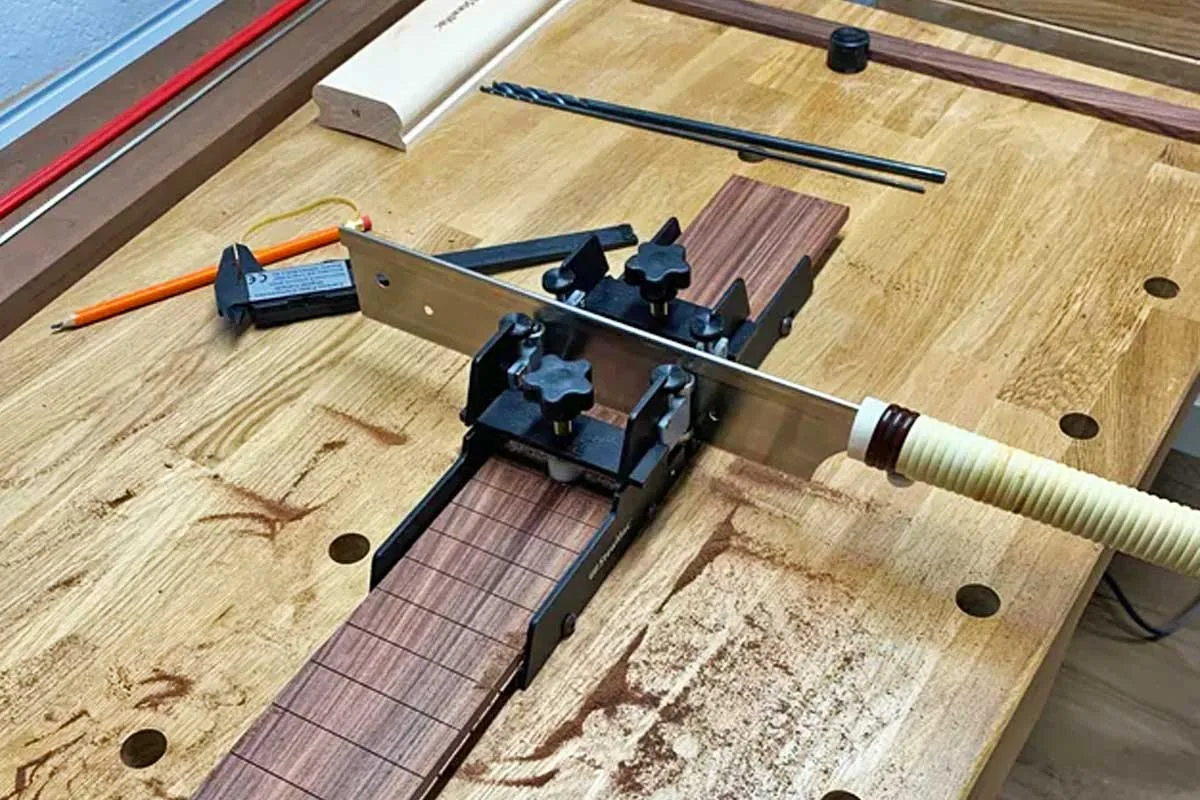When you’re making your own guitar or bass, getting those fretboard slots just right is crucial. This guitar fret position calculator is here to guide you through the process and give you precise measurements for where to cut each slot, offering both Imperial & Metric units.
To get started, plug in the scale length of your instrument and choose inches or millimeters. Then, tell the fret placement calculator how many frets you’re planning to have. Hit “calculate,” and you’ll get all the fret slot measurements you need.
Keep in mind that there might be a tiny margin of error due to rounding, but we’re talking thousandths of an inch—nothing to sweat over. Measurements are also rounded to the nearest hundredth to keep things simple and practical. With these numbers in hand, you’re all set to cut with confidence and create a fretboard that’s spot on.
If you find this useful, please share it on social media or link back to it on your website. Thanks!
| Fret | Distance From Nut (Inches) | Distance To Bridge (Inches) | Distance From Nut (Millimeters) | Distance To Bridge (Millimeters) |
|---|

What Difference Does Scale Length Make?
Scale length isn’t just a number—it’s a key factor that shapes the feel and sound of your guitar. It affects the tension of the strings, which in turn influences playability and tone. A longer scale length means tighter strings and a brighter sound, while a shorter scale length makes for easier bends and a warmer tone. Here’s a quick look at some of the most common guitars and their typical scale lengths:
| Guitar Model | Scale Length |
|---|---|
| Fender Stratocaster | 25.5″ |
| Fender Telecaster | 25.5″ |
| Gibson Les Paul | 24.75″ |
| Gibson SG | 24.75″ |
| PRS Custom 24 | 25″ |
| Fender Jaguar | 24″ |
Each of these iconic guitars has its own feel, partly thanks to these scale lengths. So, when you’re choosing a scale length for your build, think about the sound you’re aiming for and how you want the guitar to feel in your hands.
How To Measure Scale Length
Measuring the scale length of a guitar is pretty straightforward. You’ll want to measure from the front edge of the nut—the piece at the end of the fretboard where the headstock begins—to the center of the 12th fret, which is exactly halfway along the string’s vibrating length. This distance is then doubled to give you the full scale length of the instrument. It’s crucial to be precise with this measurement, as it determines the spacing of the frets and ultimately affects the intonation of your guitar. A good ruler or a measuring tape can be used for this task, and make sure to measure straight and not at an angle to keep things accurate.
Fret Spacing Theory
Fret spacing theory is all about the math that ensures each note you play is in tune. It’s based on the concept that the pitch of a string is determined by its length, and to get the chromatic scale right, each fret must be placed at a precise point. This is calculated using the “rule of 18” (or 17.817), which is a simplified version of the more accurate formula involving the twelfth root of two. By dividing the scale length by this value, you find where to place the first fret. Then, to find the next fret position, you subtract the first fret’s distance from the overall scale length and divide the remainder by the same value. Repeat this process for each subsequent fret, and you’ll get a fretboard where each fret is a semitone apart from the last, giving you the right notes all the way down the neck.
Fret Slot Cutting Techniques
Cutting fret slots requires precision to ensure your guitar plays in tune. Start by securing your fretboard to a stable work surface to prevent any movement. Using a sharp fret saw with the appropriate kerf for your fretwire is key. You can use a miter box or a fret slotting jig to guide your saw and maintain a perpendicular cut to the fretboard surface. Mark your fret positions accurately using the fretboard calculator above, template, or a straightedge and a sharp pencil or scribing tool. When sawing, apply steady, even pressure and aim for a consistent depth across all slots, which should be just a hair deeper than the tang of the fretwire. Some luthiers use depth stops on their saws to ensure uniformity. Remember, clean, well-executed cuts will make the fretting process smoother and contribute to the overall quality of your instrument.
